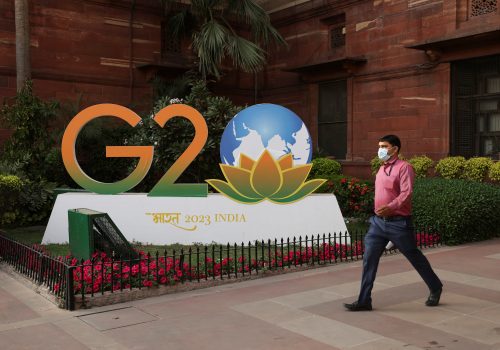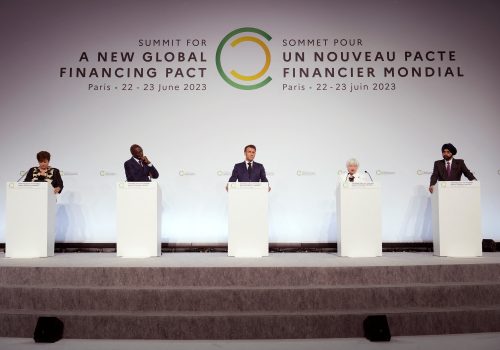The G20 still hasn’t made a breakthrough on sovereign debt restructuring
The latest meeting of G20 finance ministers and central bankers, held on July 17-18 in India, proved to be a disappointment. Among other things, the group failed to further develop a sovereign debt restructuring framework to help low-income and vulnerable middle-income countries (LVMICs)—such as Ghana, Ethiopia and Sri Lanka. In the absence of any real progress, the LVMICs in crisis will continue to face lengthy debt negotiations, compounding their distress. And China will get what it wants: a largely case-by-case approach to debt restructuring that allows it to prioritize its strategic interests.
There was hope things would go better. Last month’s debt restructuring deal with Zambia, along with the launch of the Global Sovereign Debt Roundtable (GSDR) by the International Monetary Fund (IMF) and World Bank (WB), made it seem like progress was being made toward a new set of sovereign debt restructuring principles. As US Treasury Secretary Janet Yellen stated prior to the meeting, “We should apply the principles we agreed to in Zambia’s case to other cases instead of starting from zero every time… And we must go faster.”
Now, in the wake of a meeting without tangible progress, the Zambia deal looks a little different.
There is more to the Zambia deal than meets the eye
The $6.3 billion debt restructuring agreement with Zambia and its official bilateral creditors—organized in an Official Creditor Committee—was announced at last month’s Paris New Global Finance Summit. It is useful for the country, providing it with some debt servicing relief and unlocking a $188 million disbursement from the $1.3 billion IMF Zambia program. However, the deal largely reflects China’s preferences and is less than optimal for Zambia, for several reasons.
- There is no reduction in the principal amount of the debt, but maturity dates have been extended to 2043, resulting in an average extension of more than twelve years. China has long insisted on re-profiling (of maturities and interest rates) but no principal haircuts. As a result, Zambia’s public debt/GDP ratio is unchanged from 110.8 percent in 2022.
- The interest rate on the restructured debt will be reduced to 1 percent; thereafter the rate will rise to a maximum of 2.5 percent in a base case scenario. If Zambia’s debt carrying capacity is upgraded by the IMF/WB from weak (at present) to medium, the interest rate will increase to a maximum of 4 percent, and the final maturity date brought forward to 2038 (not 2043). In their September 2022 Debt Sustainability Analysis, the IMF/WB have concluded that Zambia was close to the medium threshold. For comparison, the average interest rate on Zambia’s public debt to China is estimated to be 2.9 percent.
- In the base case scenario, with a three-year grace period for principal repayment, the present value (PV) of Zambia’s public debt being restructured has been reduced by 40 percent, assuming a 5 percent discount rate. This is shy of the 49 percent PV reduction sought by Zambia in October 2022 and less than the 50 percent PV haircuts usually granted to low-income countries in debt crisis.
- The $1.75 billion of claims insured by China’s Sinosure (including loans made by China Development Bank) will be re-classified as commercial creditor claims, not official lending as insisted by Western countries until now. This is also in line with China’s long-standing arguments.
- Consistent with the terms outlined above, each creditor country will bilaterally conclude a final restructuring agreement with Zambia—another of China’s preferences. It doesn’t matter much if such bilateral final agreements are transparent. If not, there could be suspicions of side deals beyond those agreed to, serving to erode mutual trust necessary to make progress in other cases.
- The agreement with official bilateral creditors will be contingent upon Zambia securing a comparable deal with its private sector creditors, in particular the holders of $3 billion in international bonds as part of the $6.8 billion private sector external debt. The term “contingent” is ambiguous and it’s not clear how it will be interpreted. This could delay the implementation of the official bilateral deal until a private sector deal is in place. Traditionally, a Paris Club restructuring deal is implemented right away, subject to the requirement that the debtor country seeks to obtain comparable relief from its private sector creditors.
The features mentioned above are consistent with China’s approach to dealing with its debtor countries in crisis—suggesting that Western countries and Zambia have acquiesced to China’s demands to get the deal done.
The problem with agreeing that no one size fits all
Reportedly, the G20 meeting agreed that there is no one-size-fits-all recipe for sovereign debt restructuring. That’s sensible in the sense that the specific circumstances of each debtor country should be taken into account. However, it is also consistent with China’s insistence on a case-by-case approach. This allows China to deal with debtor countries according to their strategic value to Beijing and can be used to delay rather than expedite the negotiating process.
China’s demands were also front and center in the IMF/WB launch of the Global Sovereign Debt Roundtable at their Spring meetings in April 2023. The Roundtable brought together the debtor country with all of its creditors (official bilateral, multilateral development banks and IMF, private sector creditors) to exchange views, which could inform and help actual restructuring negotiations. The IMF/WB agreed to share information more fully and more quickly with all creditors and promise to give more concessional financing, including grants to the low-income countries seeking restructuring.
This is indeed a modest step forward, especially in involving private sector creditors early on and providing them with sufficient information. If the GSDR can bring more transparency to the debt situation of the debtor country—as well as to the confidential contractual clauses in the debt owed to China—all the better! However, this is about process and has not changed the more difficult phase of reaching agreement on the scale and parameters of the debt relief—as well as how to ensure comparable burden sharing among different classes of creditors.
In short, Zambia’s debt restructuring deal and the launch of the Global Sovereign Debt Roundtable can be viewed as modest steps forward in the urgent efforts by the international community to establish a well-defined set of principles and procedures to facilitate the restructuring of sovereign debt of LVMICs—when necessary—in an efficient manner and on a timely basis. However, this goal is still far from being met, and the sovereign debt restructuring process remains unwieldy and time-consuming, deepening the crisis and ravaging the debtor country. In the meantime, the world seems to have acquiesced to China’s approach to dealing with debt crises—which is less than optimal, especially for debtor countries.
Hung Tran is a nonresident senior fellow at the Atlantic Council’s GeoEconomics Center, a former executive managing director at the Institute of International Finance and former deputy director at the International Monetary Fund.

At the intersection of economics, finance, and foreign policy, the GeoEconomics Center is a translation hub with the goal of helping shape a better global economic future.
Further reading
Wed, Jul 12, 2023
Progress on debt restructuring provides a glimmer of hope for developing countries
Econographics By
As government and private-sector creditors finally take steps to restructure debt, questions remain over their readiness to meaningfully reduce debt burdens.
Mon, Mar 20, 2023
The US debt limit is a global outlier
Econographics By Mrugank Bhusari
Debt limits are not the norm in public finance. But countries that have adopted them do not let them cause economic chaos.
Tue, Jun 27, 2023
Lessons from the Paris Summit for a New Global Financing Pact
Econographics By Hung Tran
Dressing up concrete measures as parts of a “new global financial architecture” risks conflating them with the geopolitical conflict about the future of the current world order.


